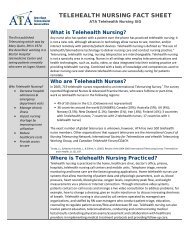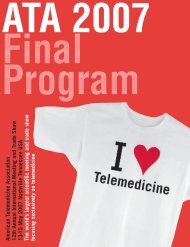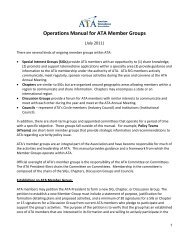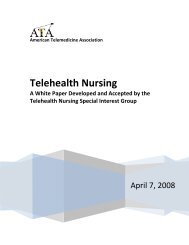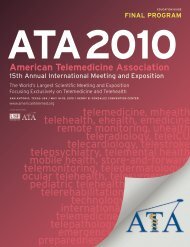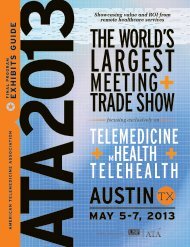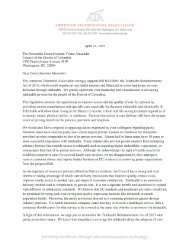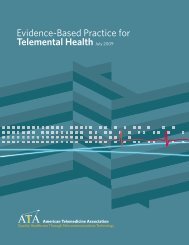Telemedicine
Presentation Abstracts - American Telemedicine Association
Presentation Abstracts - American Telemedicine Association
Create successful ePaper yourself
Turn your PDF publications into a flip-book with our unique Google optimized e-Paper software.
CONCURRENT ORAL PRESENTATIONS ABSTRACTSerage of 11.3 patients tested per practice per month. Importantly, 69% of thepatients involved had not received the recommended annual eye examinationfor diabetic retinopathy in the year preceding their retinal image assessmentperformed within the project. The retinal assessment rates for these patientsdropped to as low as 4% of patients receiving the annual eye examination inthe 4 year period prior to project initiation. Of all patients tested, 19% requiredreferral to a specialist (with 4% of all patients requiring an urgent referral). Thephysician adoption rate of the telemedicine program was 26% initially with afinal adoption rate of 50% of all invited practices. Physician’s reported thegreatest clinical value of the system in improving diabetic retinopathy assessmentrates. Patients that utilizing the system reported that returning to theprimary care physician office was more convenient than going to a specialistand less expensive.Conclusions: <strong>Telemedicine</strong> remote retinal imaging in the primary care settingmay improve rates of evaluation for diabetic retinopathy in underservedpopulations. Diabetic retinopathy assessment in the primary care setting isalso projected to decrease utilization of CMS costs for specialist visits forpatients with diabetes that are not currently at high risk for retinal disease.Furthermore, this approach may be able to support the assessment of largenumbers of patients and increase the overall quality of care for the U.S.population.Objectives:1. To describe a telemedicine diabetic retinopathy assessment program aspart of a Medicare Quality Improvement Organization.2. To discuss improvement in rates of diabetic retinopathy assessment inan underserved population.3. To understand barriers to implementation of telemedicine diabeticretinopathy programs.836 TELE-GLAUCOMA: ISSUES RELATED TO SCREENING, DIAGNOSISAND MANAGEMENT OF DISEASE REMOTELYPRESENTERS AND CONTRIBUTING AUTHORS:Yogesan Kanagasingam, PhD, MSc, BSc (Hons), National ResearchDirector 1 , Leonard Goldschmidt, MD 2 , Louis Pasquale, MD 3 ,Karim Damji, MD 4 .1 CSIRO, Floreat (Perth), Australia, 2 Dept. VA, Livermore, CA, USA, 3 MEEI,Harvard University, Boston, MA, USA, 4 University of Alberta, Edmonton, AB,Canada.Glaucoma, a group of diseases that lead to optic neuropathy, is one of themost common causes of blindness worldwide. However, the remote screeningand diagnosis of glaucoma is not well established due to lack of appropriateprotocols and the need for multiple diagnostic technologies for accurate detection.Developing such a model could allow glaucoma patients living inremote and rural locations to be managed remotely with the help of localmedical staff. However, there are limited studies indicating the efficacy ofremote management of glaucoma patients. In an attempt to initiate discussionsaround protocols for tele-glaucoma and related issues, the presenterswill discuss their experience in providing remote screening, diagnosis andmanagement of glaucoma in USA (e.g. Department of Veterans Affairs) andaround the world. The ratio between optic disk and cup (cup:disk), intraocularpressure, visual field, disk asymmetry, and nerve fiber layer loss are some ofthe important clinical indicators for glaucoma. The discussions will focus onthe screening technologies needed to obtain above mentioned clinical indicators,sensitivity and specificity of diagnostic technologies for use in teleglaucoma,and the issues related to remote management of glaucoma. Thepresenters will also explore other studies published around the world in thefield such as the benefit of using stereo imaging for the diagnosis of glaucomaand examine the viability of using OCT imaging for tele- glaucoma. The panelmembers will review various challenges related to tele-glaucoma and suggestpossible protocol based on the lessons learned in USA and around the world.Objectives:1. Understand Tele-glaucoma implementation2. Understand lessons learned globally3. learn technologies used123 CLINICAL OUTSOURCING WITH A CLOUD-BASED OPHTHALMICTELEMEDICINE SYSTEMPRESENTERS AND CONTRIBUTING AUTHORS:Neil F. Notaroberto, MD, Director 1,2 , Michael K. Smolek, PhD 2 .1 EyeCare 20/20, Mandeville, LA, USA, 2 CLEVER Eye Institute, Mandeville,LA, USA.Ophthalmic telemedicine has quietly evolved into an entirely new phase ofdelivering clinical services. Specifically, the ophthalmic and optometriccommunities have recently adopted the use of encrypted, cloud-based Internetportals where eye care providers can freely discuss clinical information in asecure environment. In order to make these cloud portals into a true telemedicineservice, automated retinal camera systems can now be purchasedthat link directly to a cloud service. This means that anyone with one or moreretinal cameras can establish their own private and secure telemedicine servicesimply by registering cameras and placing them in remote locations,provided there is a link to the Internet. Furthermore, these new retinal telemedicinecameras use robotics and on-board artificial intelligence to acquirefundus photographs with virtually no assistance from the on-site operator.The only remaining step to full automation appears to be the implementationof retinal biometric detection to associate the photographs to a specific patient’selectronic health record. These new integrated systems have the potentialto greatly expand ophthalmic telemedicine services. For example, byproviding automated cameras to many primary care physicians in a community,a single eye care provider can screen hundreds if not thousands ofpatients annually for diabetic retinopathy or other retinal diseases withouthaving to schedule these patients at his or her clinic. Likewise, vision researcherscould automatically collect and transfer large amounts of multi-siteclinical trial data to a central location with better security and privacy assurancethan current methods.Objectives:1. Develop their own ophthalmic telemedicine service.2. Understand the clinical standards for ophthalmic telemedicine.3. Describe the latest cloud-based telemedicine technology for ophthalmology.3:00 pm–4:00 pm Monday, May 6, 2013DISCUSSION PANELSession Number: 025Session Title: 264 DIRECT-TO-CONSUMERTELEDERMATOLOGY: INNOVATIONS ANDCHALLENGESTrack: InnovationsMeeting Room 18 C/DMODERATOR: April W. Armstrong, MD MPH, Director of Teledermatology,UC Davis.University of California Davis, Sacramento, CA, USA.PRESENTERS AND CONTRIBUTING AUTHORS:Mark Seraly, MD, Founder of DermatologistOnCall 1 , Ryan Hambley, BA inEconomics, Co-Founder, Co-CEO, and Head of Product Development 2 ,David J. Wong, MD, PhD, CEO 3 , Jeffrey Benabio, MD, Physician DirectorInnovation Kaiser Permanente SD.ª MARY ANN LIEBERT, INC. 2013 TELEMEDICINE and e-HEALTH A-47



